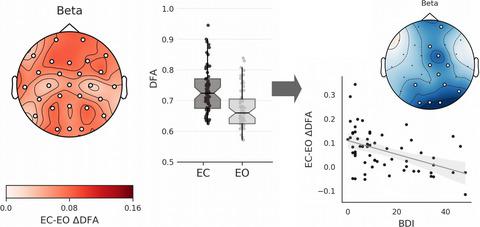当前位置:
X-MOL 学术
›
Eur. J. Neurosci.
›
论文详情
Our official English website, www.x-mol.net, welcomes your
feedback! (Note: you will need to create a separate account there.)
Intrinsic activity temporal structure reactivity to behavioural state change is correlated with depressive symptoms
European Journal of Neuroscience ( IF 2.7 ) Pub Date : 2020-06-10 , DOI: 10.1111/ejn.14858 Niall W. Duncan, Tzu‐Yu Hsu, Paul Z. Cheng, Hsin‐Yi Wang, Hsin‐Chien Lee, Timothy J. Lane
European Journal of Neuroscience ( IF 2.7 ) Pub Date : 2020-06-10 , DOI: 10.1111/ejn.14858 Niall W. Duncan, Tzu‐Yu Hsu, Paul Z. Cheng, Hsin‐Yi Wang, Hsin‐Chien Lee, Timothy J. Lane

|
The brain's intrinsic activity plays a fundamental role in its function. In normal conditions this activity is responsive to behavioural context, changing as an individual switches between directed tasks and task‐free conditions. A key feature of such changes is the movement of the brain between corresponding critical and sub‐critical states, with these dynamics supporting efficient cognitive processing. Breakdowns in processing efficiency can occur, however, in brain disorders such as depression. It was therefore hypothesised that depressive symptoms would be related to reduced intrinsic activity responsiveness to changes in behavioural state. This was tested in a mixed group of major depressive disorder patients (n = 26) and healthy participants (n = 37) by measuring intrinsic EEG activity temporal structure, quantified with detrended fluctuation analysis (DFA), in eyes‐closed (EC) and eyes‐open task‐free states and contrasting between the conditions. The degree to which DFA values changed between the states was found to correlate negatively with depressive symptoms. DFA values did not differ between states in those with higher symptom levels, meaning that the brain remained in a less flexible sub‐critical condition. This sub‐critical condition in the EC state was further found to correlate with levels of maladaptive rumination. This may reflect a general cognitive inflexibility resulting from a lack in neural activity reactivity that may predispose people to overly engage in self‐directed attention. These results provide an initial link between intrinsic activity reactivity and psychological features found in psychiatric disorders.
中文翻译:

内在活动行为状态改变的时间结构反应性与抑郁症状相关
大脑的内在活动在其功能中起着根本作用。在正常情况下,此活动是对行为情境的响应,随着在定向任务和无任务条件之间的单独切换而变化。这种变化的关键特征是大脑在相应的临界状态和亚临界状态之间的运动,这些动力学支持有效的认知处理。然而,在诸如抑郁之类的脑部疾病中,处理效率可能会下降。因此,假设抑郁症状与内在活动对行为状态变化的反应性降低有关。在一组重度抑郁症患者(n = 26)和健康参与者(n = 37)在闭眼(EC)和睁眼无任务状态下通过测量趋势内的脑电活动时间结构并用去趋势波动分析(DFA)进行量化,并在两个条件之间进行对比。发现状态之间DFA值变化的程度与抑郁症状呈负相关。在症状水平较高的州之间,DFA值之间没有差异,这意味着大脑仍处于不太灵活的亚临界状态。EC状态下的亚临界条件还被发现与适应不良的反刍水平相关。这可能反映出由于缺乏神经活动反应性而导致的一般认知僵硬,这可能使人们倾向于过度参与自我指导的注意力。
更新日期:2020-06-10
中文翻译:

内在活动行为状态改变的时间结构反应性与抑郁症状相关
大脑的内在活动在其功能中起着根本作用。在正常情况下,此活动是对行为情境的响应,随着在定向任务和无任务条件之间的单独切换而变化。这种变化的关键特征是大脑在相应的临界状态和亚临界状态之间的运动,这些动力学支持有效的认知处理。然而,在诸如抑郁之类的脑部疾病中,处理效率可能会下降。因此,假设抑郁症状与内在活动对行为状态变化的反应性降低有关。在一组重度抑郁症患者(n = 26)和健康参与者(n = 37)在闭眼(EC)和睁眼无任务状态下通过测量趋势内的脑电活动时间结构并用去趋势波动分析(DFA)进行量化,并在两个条件之间进行对比。发现状态之间DFA值变化的程度与抑郁症状呈负相关。在症状水平较高的州之间,DFA值之间没有差异,这意味着大脑仍处于不太灵活的亚临界状态。EC状态下的亚临界条件还被发现与适应不良的反刍水平相关。这可能反映出由于缺乏神经活动反应性而导致的一般认知僵硬,这可能使人们倾向于过度参与自我指导的注意力。











































 京公网安备 11010802027423号
京公网安备 11010802027423号